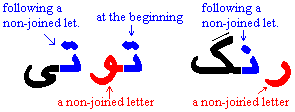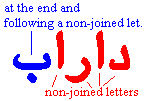 |
Script formats
Persian has a cursive script, which means that its letters are sometimes joined to one another to form a word. Generally, a letter can be connected to any letter next to it (before and after), but there are certain characters that only connect to their preceding letter but not the following; I call these types of letters non-joined letters. This page is furnished with few examples which hopefully will clarify the above statement. In the following tables I have categorised the Persian letters into two groups based on whether they are of joined or non-joined type.
 |
| joined type letters |
 |
| non-joined type letters |
There are four different forms (ways) in which a letter appears in a word depending on which position it belongs to in the word.The four different forms are:
1) A letter that appears at the begenning of a word or following a non-joined letter joins to its following letter. However if the letter is of the non-joined type, it will not be connected to its following letter.
 |
2) A letter that comes in the middle of a word joins with two other letters, but certain letters (non-joined letters) do not join with the following letter as shown in the following example:

|
3) A letter that joins with its preceding letter only; this happens when a joined type letter is at end of a word following another joined type letter. In the case of non-joined letters, this is always true no matter which part of a word it appears (i.e. a non-joined type letter joins with its preceding but NEVER to the following character).
 |
4) A letter that is at the end of a word following a non-joined letter apears without being joined with any letter. There is also NO connecting line between two adjacent non-joined type letters.
 |